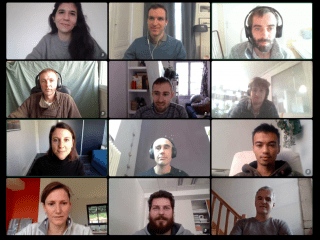The Cocoon Group
Members

Directeur de recherche
CNRS
Tel: 33 04 26 23 44 74

Chargé de recherche
CNRS
Tel: 04 72 43 29 09
Doctorant
UCBL
Tel: 04 72 44 81 42

Directeur de recherche
INRIA
Tel: 33 04 26 23 44 74
Le Cocon is both a research team and a think tank.
Research in “Le Cocon” team focuses on two main topics: multiscale evolution on one hand (i.e., studying the evolution of genetic systems while considering different levels -nucleotides, transposable elements, genes, genomes, microbiomes, organisms, populations, species, geography-), and environmental issues on the other hand. In both cases, we rely on modeling and data analysis, using a combination of statistics and computer science.
Le Cocon is also a place to think about the responsibilities of research and researchers in the anthropocene era, and about the role of non-researcher citizens in orienting and conducting research.
Multiscale evolution
- We have a long history of working on gene transfers. We develop new methods to detect these events in complex systems involving more than two levels (host, symbiont and parasites for example) and
- We use horizontal transfer detection to date species trees and to infer yet unknown biodiversity (extinct and unsampled) (Sthoriz (ANR, 2018)) .
- We have a lasting interest into convergent genomic evolution (Convergenomics - ANR, 2015)
- We question the usual way of testing bioinformatic methods (Evoluthon - ANR, 2019)
- We study the interaction between human populations, their lifestyles, and their gut microbiota (Microregal - ANR, 2015). We are notably interested in identifying cases of host-microbe coevolution and in better understanding transmission dynamics.
Environmental issues
- We develop computational methods to support an agriculture that relies on ecosystemic relationships between crops, the soil, its microbiota, and wild plants and animals (Community Garden Book - Inria, 2019)
- We develop statistical approaches to understand and predict crop yield variability with respect to meteorological conditions
Research in the anthropocene
- We participate to the science shop (UdL), the ethics platform (UdL), Labo1.5, the open science committee, Sciences Citoyennes, the shift project
- We organize a series of seminars to help us think about the position of scientific research in the history of the anthropocene, and about the position of scientists in the future of the anthropocene.
- We assemble committees of citizens to investigate to what extent scientific research can be democratized.
Teaching and outreach
- We teach at University of Lyon, University Lyon 1, INSA, Inria, ENS Lyon, we organize bioinformatics internships
- We regularly participate in the Fête de la Science, have contributed videos in the public transportation system in Lyon, give conferences at Université Populaire and contribute articles in general public journals.
- We develop the software Lifemap to explore the tree of life on computers and smartphones.
Prospective students and postdocs are invited to apply, as we often welcome visitors for internships or research projects.
Publications
Display of 91 to 120 publications on 222 in total
GC-Content evolution in bacterial genomes: The biased gene conversion hypothesis expands
PLoS Genetics . 11 ( 2 ) : 1-20
Journal article
see the publicationKaryotype and Gene Order Evolution from ReconstructedExtinct Ancestors Highlight Contrasts in Genome Plasticity ofModern Rosid Crops
Genome Biology and Evolution . 7 ( 3 ) : 735-749
DOI: 10.1093/gbe/evv014
Journal article
see the publicationFoundations of Coding: Compression, Encryption, Error-Correction
978-1-118-88144-6 : 376
Book
see the publicationAncestral gene synteny reconstruction improves extant species scaffolding
BMC Genomics . 16 ( Suppl 10 ) : S11
Journal article
see the publicationProbabilistic modeling of the evolution of gene synteny within reconciled phylogenies
BMC Bioinformatics . 16 ( Suppl 14 ) : S5
Journal article
see the publicationGenome-scale phylogenetic analysis finds extensive gene transfer among fungi
Philosophical Transactions of the Royal Society of London. Series B, Biological Sciences (1934–1990) . 370 : 20140335 (11 pages)
Journal article
see the publicationPhylogeny of the class Actinobacteria revisited in the light of complete genomes. The orders 'Frankiales' and Micrococcales should be split into coherent entities: proposal of Frankiales ord. nov., Geodermatophilales ord. nov., Acidothermales ord. nov. an
International Journal of Systematic and Evolutionary Microbiology . 64 ( Pt 11 ) : 3821-32
Journal article
see the publicationCounting and sampling SCJ small parsimony solutions
Theoretical Computer Science . 552 : 83-98
Journal article
see the publicationFungal evolutionary genomics provides insight into the mechanisms of adaptive divergence in eukaryotes
Molecular Ecology . 23 ( 4 ) : 753-773
DOI: 10.1111/mec.12631
Journal article
see the publicationMassive gene swamping among cheese-making Penicillium fungi
Microbial Cell .
Journal article
see the publicationHigh Variability of Mitochondrial Gene Order among Fungi
Genome Biology and Evolution . 6 ( 2 ) : 451-465
DOI: 10.1093/gbe/evu028
Journal article
see the publicationReductive genome evolution at both ends of bacterial population size spectrum
Nature Reviews Microbiology . 12 ( 12 ) : 841-850
DOI: 10.1038/nrmicro3331
Journal article
see the publicationRibosomal proteins: Toward a next generation standard for prokaryotic systematics?
Molecular Phylogenetics and Evolution . 75 : 103 - 117
Journal article
see the publicationSingle acquisition of protelomerase gave rise to speciation of a large and diverse clade within the Agrobacterium/Rhizobium supercluster characterized by the presence of a linear chromid
Molecular Phylogenetics and Evolution . 73 : 202-207
Journal article
see the publicationA Bayesian Method for Analyzing Lateral Gene Transfer
Systematic Biology . 63 ( 3 ) : 409 - 420
Journal article
see the publicationIdentification de complexes protéine-protéine par combinaison de classifieurs. Application à Escherichia coli
EGC 2013 - 13eme conférence Francophone sur l'Extraction et la Gestion des Connaissances . E.24 : 419-430
Conference paper
see the publicationLateral Gene Transfer from the Dead.
Systematic Biology . 62 ( 3 ) : 386-397
Journal article
see the publicationContrasted evolutionary constraints on secreted and non-secreted proteomes of selected Actinobacteria
BMC Genomics . 14 ( 1 )
Journal article
see the publicationLateral gene transfer, rearrangement, reconciliation
BMC Bioinformatics . 14 ( Suppl 15 ) : S4
Journal article
see the publicationThéorie des Codes : compression, cryptage, correction, 2e edition
9782100599110 : 384
Book
see the publicationGene tree correction guided by orthology
BMC Bioinformatics . 14 ( Suppl 15 ) : S5
Journal article
see the publicationDuplication, Rearrangement and Reconciliation: A Follow-Up 13 Years Later
Models and Algorithms for Genome Evolution . 19 : 47-62
Book chapter
see the publicationEfficient Exploration of the Space of Reconciled Gene Trees.
Systematic Biology . 62 ( 6 ) : 901-912
Journal article
see the publicationGenome-scale coestimation of species and gene trees.
Genome Research . 23 ( 2 ) : 323-330
Journal article
see the publicationLineage selection and the maintenance of sex
PLoS ONE . 8 ( 6 ) : e66906
Journal article
see the publicationFPSAC: Fast Phylogenetic Scaffolding of Ancient Contigs
Bioinformatics . 29 ( 23 ) : 2987-2994
Journal article
see the publicationTPMS: a set of utilities for querying collections of gene trees.
BMC Bioinformatics . 14 : 109
Journal article
see the publication
